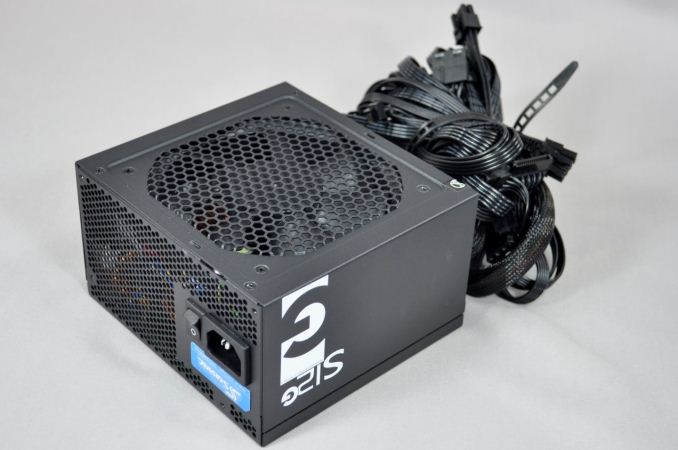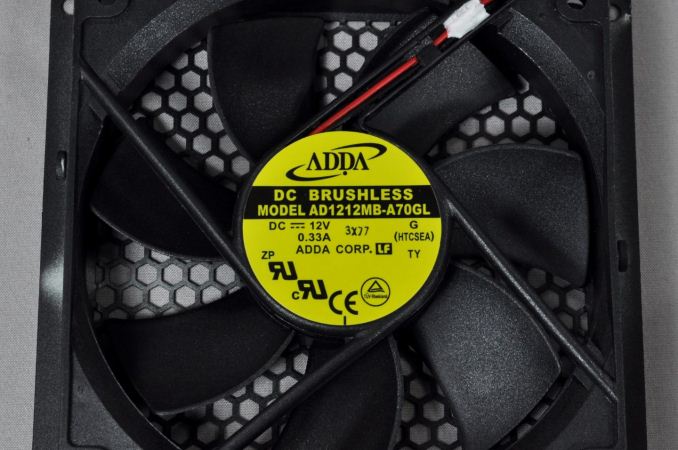Seasonic S12G 650W Power Supply Review
by E. Fylladitakis on February 28, 2014 2:20 PM EST- Posted in
- Cases/Cooling/PSUs
- Seasonic
- 80 Plus Gold
External Appearance
The Seasonic S12G sports a small, typical ATX-sized (140mm) chassis that has been sprayed with a matte black paint. Some effort has been made to improve the appearance of the power supply, albeit not all of the measures can be considered successful. Seasonic uses all-black ribbon cables, with the exception of the 24-pin ATX cable that uses typical color-coded wires and sleeving. A blue sticker has been placed on the rear of the unit, where it will be visible from the back of a case once the PSU has been installed. Oddly enough however, the company sprayed the series logo in white on the right side of the chassis, where it will be facing the right side panel of a case. It goes without saying that it will not be visible inside the vast majority of the cases currently in the market. On the other hand, the sticker with the specifications of the PSU has been placed on the left side of the chassis. No effort has been made at all to enhance the top side of the chassis visually, so in a bottom-mounted location users with case windows will simply see a black surface.
Internal Design
We were surprised the instant that we opened up the chassis of the S12G 650W unit. The unit is cooled by an ADDA AD1212MB-A70GL fan, unlike the majority of Seasonic's other models that use SanAce fans. The particular fan model is high quality, featuring a "Hypro" liquid bearing and with a maximum speed of 2050 RPM, yet it is no SanAce. When you have to compete in the mainstream market and even a few dollars can make an immense difference on sales, you have to keep the retail price as low as possible, which is most probably why Seasonic went with the ADDA fan for the S12G. Note also that as this unit has no fanless mode, it does not require a fan with extraordinary specifications (e.g. a very low starting voltage).
It is obvious that the OEM behind the S12G is Seasonic, as the company designs, manufactures, and markets their own units. We spot four heatsinks; the smallest one handles the rectifier bridge, the one near the edge of the PCB cools the active PFC components, and those on each side of the main transformer handle the inversion and conversion transistors of the primary and secondary stage respectively. The input filter begins on the PCB attached to the back of the receptacle, but continues on the main PCB until the input of the rectifier bridge. We spot a total of six Y capacitors, two X capacitors, and two filtering inductors, which form an excellent intake filter.
In terms of component and build quality, Seasonic does not let us down. The primary capacitor and most of the smaller capacitors are supplied by Nippon Chemi-Con, with some Rubycon electrolytic capacitors after the secondary side heatsink as well. Everything is well shielded and secured with glue, ensuring the mechanical cohesion of the unit. The inductors are glued and also tightened with cable ties, in order to minimize the chance of vibration-generated noise (also known as "coil whine"). The quality of the soldering is very good, well above what we would consider average. There are a few spots where excessive solder has been applied, but that hardly is worth commenting on in a $90 MSRP PSU.






















77 Comments
View All Comments
WoodyPWX - Friday, February 28, 2014 - link
Ordered, thanks!mark28 - Friday, February 28, 2014 - link
How's their fanless PSUs now? The last few I got had a really annoying constant buzzing sound.Sivar - Friday, February 28, 2014 - link
I returned two of them before I ordered a Rosewill SilentNight (same as Kingwin Stryker STR-500). I heard the new generations of Seasonic are almost always silent, but I'm happy with the SilentNight, too.stratum - Saturday, March 1, 2014 - link
I got a fanless Seasonic PSU last month and the constant buzz was more annoying than a PSU with a fan. Waste of money when my main reason for getting it was negated.motas - Saturday, March 1, 2014 - link
For my builds that rarely draw 250 W max, after how reliable the PSU is, the next thing I care most about is the noise. Not just dBA numbers but also how it sounds. You could look at the frequency spectrum and most of the sounds people would find more annoying would show a pattern. A fan putting out 30 dBA could sound "worse" than one at 35 dBA. Last I care about is efficiency. As long as the PSU can reliably provide the requested power then I'm good. I'm not runing servers or crypto miners at constant load 24/7.E.Fyll - Saturday, March 1, 2014 - link
"A" in "dB(A)" stands for "acoustic", i.e. it is within the part of the dB range that your ears can perceive. You are actually right that a fan rated at 30 dB(A) can actually sound worse than a fan rated at 35 dB(A), but that's because these readings/ratings are being taken inside anechoic chambers. It is possible that due to vibrations or simply because of the frequency the sound is emitted at (reflections, echo, etc), the first fan could actually sound worse than the second fan inside a real room; but the instruments would read that as well. We are doing noise testing inside a real room so that is as close to reality as it gets.I understand that some "types" of noise might be more bothersome than others to some people, but that is relative and mostly psychological; I cannot possibly assess that quantifiably.
morso - Saturday, March 1, 2014 - link
How about provide a frequency spectrum plot. You know, white noise vs colored noise. People can then decide for themselves if the sound is good or not.g.davis - Saturday, March 1, 2014 - link
If that's not possible then maybe record the sound and post an audio file. Hopefully, the recording process can be standardized. That buzzing sound from a fanless Seasonic PSU was extremely annoying especially for a bedroom PC that doesn't get turned off. I'd rather get a louder PSU with a fan. Which I did.E.Fyll - Saturday, March 1, 2014 - link
You actually suggested inserting a graph with spectral profiles in a review?People cannot decide "if the sound is good or not" by looking at such a graph, not only because it will not tell you anything of actual relevance but because, well, they cannot read it. Aside the fact that only a handful people can actually read such a graph, do you realize the kind of equipment that is required to generate it? Space aside, we are talking about hundreds of thousands of dollars.
This is absolutely out of the question, sorry.
tosisgray - Saturday, March 1, 2014 - link
Why not provide an audio recording. Sometimes it's the subjective parts people care about most. With your statement, it seems you're not targeting professiosnals anyway. Efficiency doesn't matter much to the crowd you seem to be targeting unless the vendor is falsely advertising their product. These PSUs will likely go inside homes. Maybe bedrooms and living rooms.